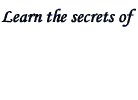 |
Your worst enemy, how do we beat it?
Cancer is the second common cause of death in Australia and in USA. In Australia between 1990 and 1996 the incidence for all cancers (apart from non-melanocytic skin cancers) rose for both sexes by 2.1% for males and 1.4% for females. 20
More than two-thirds of cancers could be prevented by lifestyle changes such as not smoking, a good diet and exercise 8. Diet accounts for about 35 per cent of all cancers 3. Nearly 80,000 new cases of cancer are diagnosed each year 9. This equates to an average risk of 1 in 3 men and 1 in 4 women being directly affected by cancer 4. In USA one in every three will die from a kind of cancer. Cancer claims the life of more than 500,000 people a year 7.
In USA 42% of men and 39% of women at some stage in their lives are expected to develop cancer. The incidence of breast cancer is 11% and prostate cancer 12% 19.
Despite all advancements in medical science and improvement in treatment of some types of cancer, we are far from winning the war against cancer 7.
What are the risk factors for cancer development?
Smoking is a major risk factor and an ugly habit. It is a major cause of death in cancer and heart disease. Smoking is associated with 33% of all cancers in USA 6.
Benzpyrenes are carcinogenic substances released from cigarette smoke.
Benzpyrenes change the metabolism within the lung cells, which become cancerous. There may be radioactive substance in a cigarette, which could be a risk factor in carcinogenesis.
Nuclear radiation. Chemicals in the environment, herbicides, pesticides, chemical solvents, UV light, soot, high fat diet, excessive alcohol consumption, charcoals steaks, viruses and saccharine are all carcinogens, which increase the risk of cancer.
Sugars and a high calorie diet are also associated with cancer promotion. They all have one thing in common and that is they all promote free radical production. Free radical damage to the cell and oxidative stress is one of the bases for cancer development.
|
 |
Obesity is also a major risk factor for cancer development due to lipid oxidation. A study was done by The American Cancer Society from 1959 to 1980. The result was nothing short of amazing. The study demonstrated that people who were 40% or more overweight had a greater chance of developing a variety of all cancers. This seems to be as a result of too much fat in the body. Too much fat when oxidised causes DNA and cellular damage. About 24% of all cancers seem to be connected with obesity. 6
Free radical theory and cancer
As discussed earlier free radicals are abnormal atoms with one electron missing in their outer orbit. These unstable atoms are capable of damaging any part of the cell including DNA. When DNA of the cell is damaged it becomes abnormal which can lead to mutation of the cell. This mutated cell grows and multiplies into two abnormal cells. Two become 4, 8, 16, 32, 64, 128, 256 and so on. As there is more free radical damage to DNA the more abnormal cells are created. By now the tumour takes a life of its own and multiplies out of proportion and at this stage metastasis occurs. For instance, cigarette smoking generates a huge amount of free radicals, which damages DNA of the lung cells hence developing cancer. Sun irritation due to UV light causing skin cancer is another example of free radical damage.
Studies have demonstrated an increase of free radicals in the lung tissue of individuals with lung cancer. The studies have also shown that individuals who eat more fruits and vegetables are less likely to develop any type of cancer. Indeed, research has revealed that those who do not eat enough fruits and vegetables regularly are twice as much in danger of developing cancer later in life. This is because antioxidants in fruits and vegetables, which have a preventative effect against cancer. I recommend where possible 5-7 servings of good organic fruits and vegetables every day.
For more detailed information and specific recommendations, please [click here] to become a member of DrHabibi.com
|
 |




